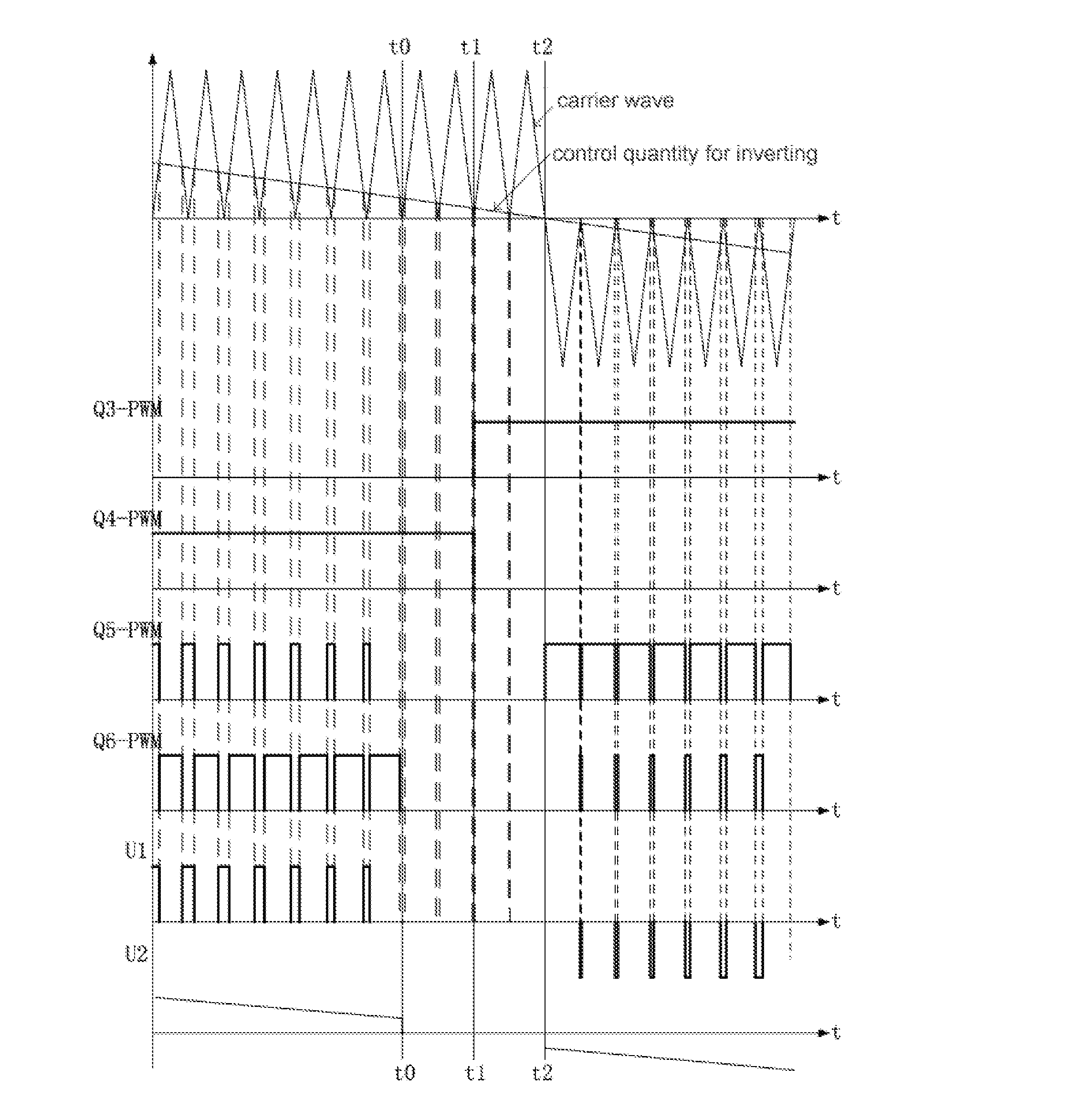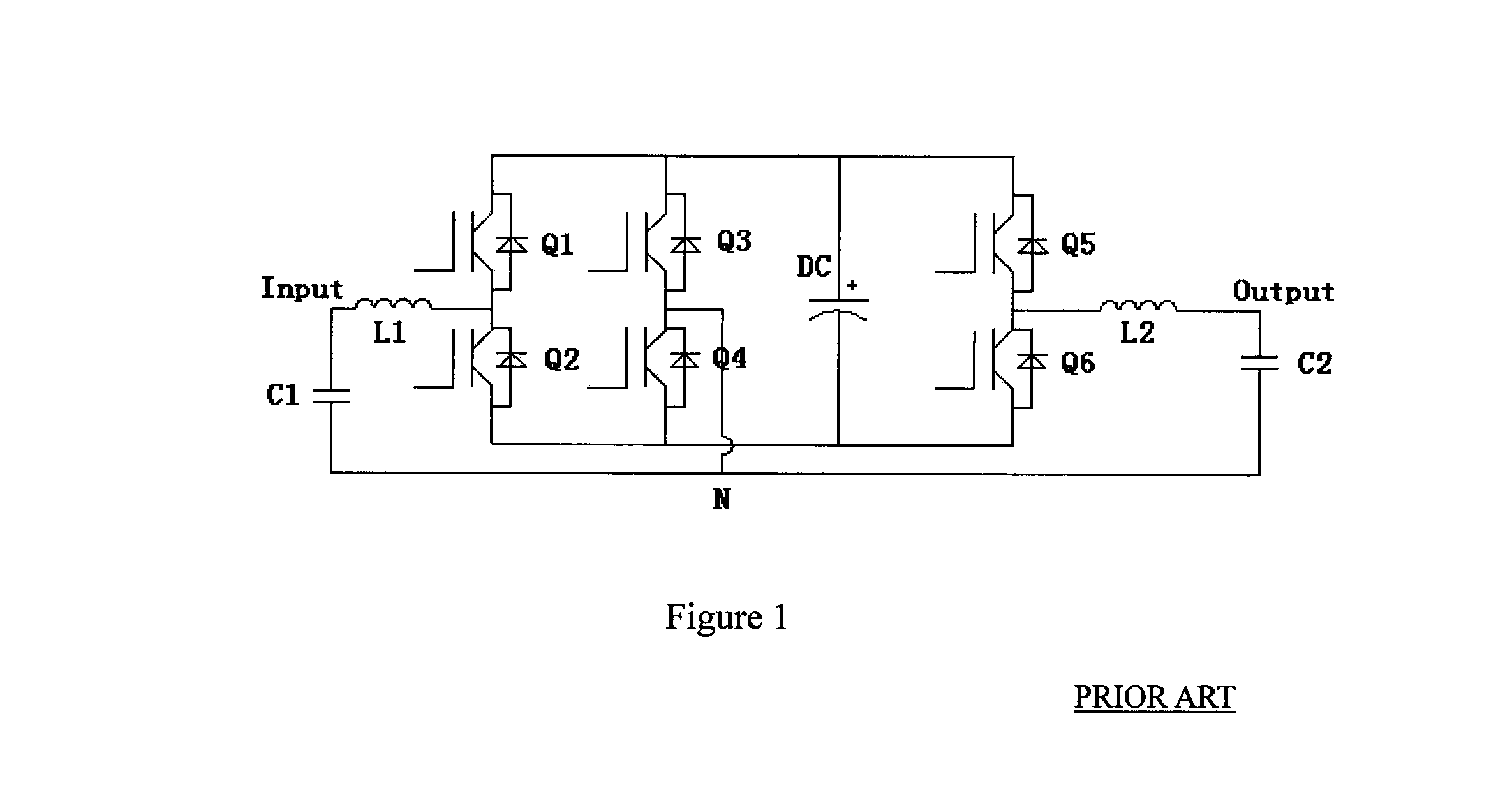Control Method During Zero-Crossing Operation Of Bridge Arms In UPS
a control method and bridge arm technology, applied in emergency power supply arrangements, climate sustainability, energy industry, etc., can solve the error of zero-crossing synchronization between the pfc circuit and the inverter circuit, and the power consumption thereon is small, so as to reduce the influence and achieve simple and easy implementation
- Summary
- Abstract
- Description
- Claims
- Application Information
AI Technical Summary
Benefits of technology
Problems solved by technology
Method used
Image
Examples
embodiment 1
[0031]The schematic waveform of the control signal in this embodiment is shown in FIG. 2. The waveforms Q3-PWM, Q4-PWM, Q5-PWM, and Q6-PWM correspond to the driving signals of the third switching transistor Q3, the fourth switching transistor Q4, the fifth switching transistor Q5 and the sixth switching transistor Q6, respectively. The waveform labeled U1 is a pulse-width modulation voltage outputted by an inverter bridge arm. A desired sine waveform voltage U2 is obtained after being filtered by an inductance L2 and a capacitance C2. Time t1 is the zero-crossing point of the PFC circuit from the positive half cycle to the negative half cycle. Due to the synchronization error the zero-crossing point of the inverter circuit from the positive half cycle to the negative half cycle is different from the zero-crossing point of the PFC circuit from the positive half cycle to the negative half cycle, and the time differences in various cycles may be different but the time difference betwee...
embodiment 2
[0036]The difference between the present embodiment and the embodiment 1 is that the present embodiment is the control of the rectifying bridge arm from the negative half cycle to the positive half cycle, while embodiment 1 is the control of the rectifying bridge arm from the positive half cycle to the negative half cycle.
[0037]The schematic waveform of the control signal in this embodiment is shown in FIG. 4. Waveforms Q3-PWM, Q4-PWM, Q5-PWM, and Q6-PWM correspond to the driving signals of the third switching transistor Q3, the fourth switching transistor Q4, the fifth switching transistor Q5 and the sixth switching transistor Q6, respectively. Waveform U1 is a pulse-width modulation voltage outputted by an inverter bridge arm, which is filtered by an inductance L2 and a capacitance C2 to produce a desired sine waveform U2. Time t4 is the zero-crossing point of the PFC circuit from the negative half cycle to the positive half cycle. Because of the synchronization error, the zero-cr...
embodiment 3
[0041]The difference between the present embodiment and the preceding two embodiments is that the present embodiment controls the midline bridge arm and the inverter bridge arm to cross zero synchronously, and disconnects the rectifying bridge arm during a period before and after zero-crossing of the inverter. The preceding two embodiments, however, control the midline bridge arm and the rectifying bridge arm to cross zero synchronously and disconnect the inverter bridge arm during a period before and after zero-crossing of the rectifying bridge arm.
[0042]FIG. 6 is the schematic waveform of the control signal in the present embodiment. As shown in FIG. 6, Q1-PWM, Q2-PWM, Q3-PWM, and Q4-PWM correspond to the driving signals of the first switching transistor Q1, the second switching transistor Q2, the third switching transistor Q3, and the fourth switching transistor Q4, respectively. The IL waveform is the current on the inductance L1. Time t7 is the zero-crossing point of the invert...
PUM
 Login to View More
Login to View More Abstract
Description
Claims
Application Information
 Login to View More
Login to View More - R&D
- Intellectual Property
- Life Sciences
- Materials
- Tech Scout
- Unparalleled Data Quality
- Higher Quality Content
- 60% Fewer Hallucinations
Browse by: Latest US Patents, China's latest patents, Technical Efficacy Thesaurus, Application Domain, Technology Topic, Popular Technical Reports.
© 2025 PatSnap. All rights reserved.Legal|Privacy policy|Modern Slavery Act Transparency Statement|Sitemap|About US| Contact US: help@patsnap.com



